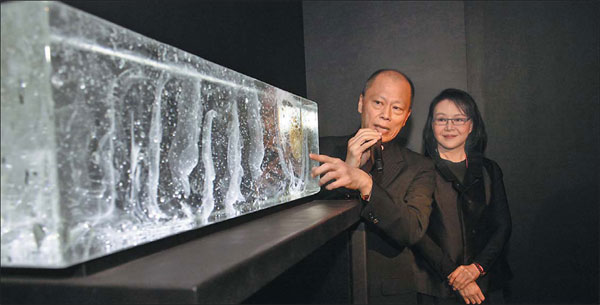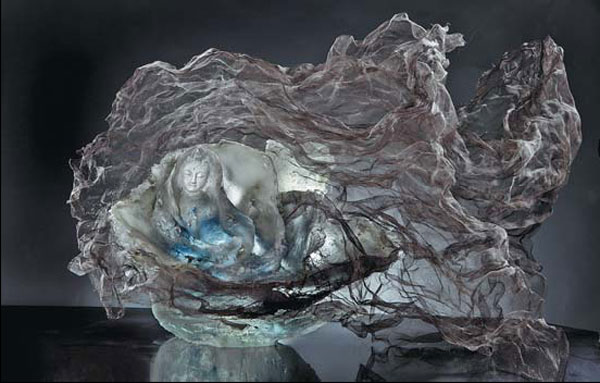
 'Taken 2' grabs movie box office crown
'Taken 2' grabs movie box office crown
 Rihanna's 'Diamonds' tops UK pop chart
Rihanna's 'Diamonds' tops UK pop chart
 Fans get look at vintage Rolling Stones
Fans get look at vintage Rolling Stones
 Celebrities attend Power of Women event
Celebrities attend Power of Women event
 Ang Lee breaks 'every rule' to make unlikely new Life of Pi film
Ang Lee breaks 'every rule' to make unlikely new Life of Pi film
 Rihanna almost thrown out of nightclub
Rihanna almost thrown out of nightclub
 'Dark Knight' wins weekend box office
'Dark Knight' wins weekend box office
 'Total Recall' stars gather in Beverly Hills
'Total Recall' stars gather in Beverly Hills
Crystal clear
Updated: 2013-04-24 05:32
By Chen Jie (China Daily)
|
||||||||

|
Above and bottom: Two works of liuli by Loretta Hui-shan Yang. Photos provided to China Daily |
Limelight | Loretta Hui-shan Yang and Chang Yi
One is an award-winning actress, another a once promising movie director from the 1980s. Today, the duo is better known for creating liuli, Chinese glass art works that have a rich yet little known history dating back thousands of years, Chen Jie reports.
It began one night in Taipei, in 1984. Chang Yi, 33, sat opposite Loretta Hui-shan Yang, 32, at a dinner hosted by senior director Lee Hsing.
Back then, Chang was one of the young directors in Taiwan's New Wave Cinema, who was going to adapt Kenneth Hsien-yung Pai's Madam Yu Ching (Jade Love) into a film, and Yang, was one of the most popular actresses at that time. The other guests at the dinner included several producers and the writer Pai.
"He was young, good-looking, did not talk much," Yang remembers.
"She was getting all the attention but did not look interested in the movie," Chang recalls.
But he remembers her hands because in his mind, the title role Madam Yu Ching - who loses her husband at a young age, secretly and desperately falls in love with another young man and finally kills him before committing suicide when she finds out he has a new lover - must have impressive hands.
What Chang did not expect was, years later, the hands would became even more impressive away from the screen, making glass into art as Yang would go from being an award-winning actress to a sculptor.
Having that story in mind, my eyes focus on Yang's hands instead of her face as she walks into the room. Before I even scan for signs of aging, she offers her right hand and the firm handshake impresses me. It is this hand that mixes wax with water, tests the temperature of kiln and sculpts the glass into all kinds of shapes.
To those under the age of 35, Yang and Chang are known for creating liuli, Chinese crystal glass, rather than as actress and director. Titled Uncovering Liuli in This Mortal World, their exhibition at the National Art Museum of China will run until May 12. It displays some 50 works in five series, including "A Chinese Liuli Flower", "A Realm Of Zen Within Fire", "Enlightenment", "Free Mind", and "Formless, But Not Without Form".
Breakthrough
Yang was a student at Providence University in the early 1970s when a TV producer discovered her during a bus trip home.
"I never thought I was pretty and my girlhood dream was to be a teacher like my father or a secretary," says Yang, adding that most of the female graduates from Providence University ended up becoming secretaries.
Yang was a gifted and hardworking actress. She appeared in 124 movies in 12 years, in roles ranging from a girl next door to a cold gangster widow, from kung fu fighter to noble lady. Her record was playing 22 films in one year. All the posters in cinemas featured her face. She even had several movies competing against each other for box-office revenue.
Her breakthrough came in 1984. The movie The Young Runaway earned her best actress at the Golden Horse Awards, Taiwan's highest prize in the movie industry. The same year, Jade Love won both the best actress and best director at the Asian Pacific Film Festival Awards. The next year, Yang's second movie directed by Chang, Kuei-Mei, A Woman, won both the best actress and director at the Golden Horse Awards.
Naturally and unconsciously, love blossomed between Chang and Yang when they collaborated on their third movie, My Love. But it was not a romantic tale. Chang was already married. His wife wrote a public letter to the newspaper accusing Chang of betrayal and condemning Yang for being a family wrecker.
Most people assumed this to be the main reason that "forced" them to retreat from the screen, but Chang says there is more to it.
"I did not enjoy directing movies in Taiwan any longer," he says.
He says that Edward Yang, another Taiwan New Wave director who was US-educated, told Taiwan stories in a Western way. Chang's family moved from Beijing to Taiwan and he did not feel much cultural connection with Taiwan.
"When I shot Jade Love, I did not know what Pai's house looked like in the 1930s. (Pai wrote the story based on his own childhood memory.) Taiwan's movies were all using the miniature scenes or model landscapes. I really hated it," says Chang.
More than that, he was tired of bowing to rich people who invested in his movies. Sophisticated movies exploring social problems did not sell well, and investors did not want to take risks.
There was also stringent censorship in Taiwan at that time, he says. Though Kuei-Mei, A Woman garnered best movie, best actress, best director and best script at the Golden Horse Awards, the movie watchdogs made Chang change, cut and even stop several times during shooting.
Those were the reasons that prompted him to leave the industry.
What happened to Yang who was at the peak of her career as an actress?
"For an actress, 34 is not the best age on screen," Yang says without any hesitation.
She chose to be his actress forever in life instead of on screen.
Like most people with fame and wealth, they first tried to invest in business and real estate. But soon, they found that was not what they wanted.
"Both of us want to find something meaningful, lasting and deserving our lifetime devotion," Chang says.
For a reason
Yang believes that everything happens for a reason. The experience in movies prepared her for creating glass art. In their final movie My Love, they borrowed some glass art pieces as props. They were impressed by the material, which they once thought was only used to make cups and vases.
"Glass is transparent. I feel I can see through it, right into the heart. I remember one particular piece a fish in water. The sculptor even had some bubbles in the glass which made the fish look alive," says Yang.
In 1987, seven people from the movie industry including Chang and Yang established Liuligongfang as Asia's first crystal glass workshop.
The hardship was far beyond what they expected.
Initially, they planned to only work on design and get glass factories to produce the product, because some of Liuligongfang's founders were movie setting and props designers. Yang herself is talented in painting.
But soon they found it was impossible to find the right partner to manufacture quality products.
So they invested in a dilapidated factory and learned from scratch the techniques and craftsmanship called pate-de-verre. The process involves casting a wax sculpture in plaster, melting out that wax and adding glass ingredients to the leftover negative space.
For the group who had no knowledge of glass work, it was a tall order. Yang and Chang sold their houses and even refinanced their parents and brothers' houses. In the first three-and-a-half years, they invested some $3 million and "led a life without knowing if there is enough to survive tomorrow".
In 1991, they presented their first exhibition in Japan. They were proud to showcase their pate-de-verre technique, which they thought was invented in Egypt and revived by the French in the 19th century, until a Japanese expert told them Chinese mastery of the technique dates back to the Han Dynasty (206 BC-220 AD). The Japanese told them there was a pair of 11.5-cm liuli ear cups unearthed from the famed tomb of Emperor Liu Sheng in Hebei province.
They were dumbfounded and felt ashamed that as Chinese, they were so oblivious of their own history.
That is why they do not call their works "crystal glass" but "liuli". The term liuli first appeared in the Western Zhou Dynasty (c. 11th century-771 BC) as a reference to the lead-barium glass produced at the time. The term represents their respect for Chinese culture and history, and their commitment to promote the cultural legacy.
When they presented the first exhibition on the mainland, at the Palace Museum in 1993, they had the Han liuli ear cups specially installed together with their works as a form of respect to their predecessors.
Over the last 25 years, Yang and Chang have spent all their efforts learning, experimenting and creating glass art works, which are richly imbued with a traditional Chinese artistic vocabulary and human philosophy.
In 1996, they visited Dunhuang Mogao Grottoes in Gansu province. While impressed by the beauty of the colorful murals they also found out many of the murals are gradually deteriorating. It prompted Yang to create murals using liuli.
For five months in 1999, Yang and her team worked day and night to sculpt the Guanyin of Thousand Arms and Eyes in Dunhuang's third grotto. In May 2000, a 160-cm liuli Guanyin made its debut in Dunhuang. She also created a 4.4-meter-tall Guanyin to exhibit in Taiwan, Singapore and Shanghai.
"Every great craft has its rise and fall. The brilliant light of liuli has shone through thousands of years of Chinese history," Chang says. "Perhaps we can do more than revive an art. We can also maintain a cultural spirit by learning to respect the tradition. Through liuli sculpture, we tell Chinese stories and convey the message of the significance of inheriting the past and passing the emotion on to future generations."
Contact the writer at chenjie@chinadaily.com.cn.
(China Daily 04/24/2013 page18)
Most Viewed
Editor's Picks

|

|

|

|

|

|
Today's Top News
Sluggish growth takes its toll on foreign lenders
Investors find a home in overseas real estate
More Chinese travel overseas, study reveals
Xi meets former US heavyweights
Li in plea to quake rescuers
Canada to return illegal assets
Beijing vows to ease Korean tensions
Order restored after deadly terrorist ambush
US Weekly

|

|







